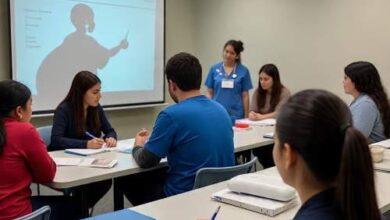Easy Guide: Credential Assessment Guide for Nurses Immigrating to Canada 2025

Credential Assessment Guide for Nurses Immigrating to Canada 2025
Immigrating to Canada as a nurse requires more than just professional experience—it begins with a proper evaluation of your qualifications to ensure they meet Canadian healthcare standards. This Credential Assessment Guide for Nurses Immigrating to Canada provides a step-by-step explanation of the process every internationally educated nurse (IEN) must follow before practicing in the country.

Since Canada relies on credential verification to maintain its high-quality healthcare system, understanding how to navigate this requirement is crucial for a smooth migration and successful licensing journey.
For nurses trained outside Canada, credential assessment is conducted primarily through the National Nursing Assessment Service (NNAS). This independent body reviews your academic transcripts, professional licenses, employment history, and language proficiency to determine whether your education and skills are equivalent to Canadian standards. Once your credentials are assessed, you can proceed to register with a provincial regulatory body such as the College of Nurses of Ontario (CNO) or the British Columbia College of Nurses and Midwives (BCCNM). Without this first step, you cannot qualify for registration, licensure, or even apply for most nursing jobs in Canada.
This guide explains the entire process in detail: from creating an NNAS account, submitting documents, and understanding timelines, to the costs involved and common challenges nurses face. It will also outline strategies to make your application easier, including how to prepare supporting documents from your home country, how long the assessment typically takes, and what to expect once your report is ready.
By the end of this article, you will have a clear understanding of how credential assessment works, why it is mandatory, and what you can do to increase your chances of a successful application in 2025. Whether you are from Nigeria, India, the Philippines, or any other country, this Credential Assessment Guide for Nurses Immigrating to Canada will serve as your roadmap to starting a nursing career in one of the world’s most respected healthcare systems.
Complete Guide: Express Entry vs PNP Nurses: Which Path Is Best for Nurses Seeking Canada PR 2025
Step 1: Understanding the Role of NNAS in Credential Assessment
The National Nursing Assessment Service (NNAS) is the official organization responsible for evaluating the credentials of internationally educated nurses (IENs) who wish to work in Canada. Before you can apply to any provincial nursing regulatory body, you must first create an NNAS account and submit your documents for verification. This process ensures that your nursing education, professional license, and work history meet Canadian standards.
The NNAS assessment is mandatory for all nurses in the following categories:
-
Registered Nurses (RNs)
-
Licensed Practical Nurses (LPNs) or Registered Practical Nurses (RPNs)
-
Registered Psychiatric Nurses (RPNs) (in certain provinces like British Columbia, Alberta, Manitoba, and Saskatchewan)
Why NNAS Credential Assessment Is Important
-
Verification of authenticity – Confirms that your transcripts, licenses, and employment history are valid and issued by recognized institutions.
-
Standardization – Ensures that international qualifications are compared fairly to Canadian benchmarks.
-
First requirement for licensure – Without an NNAS Advisory Report, provincial nursing bodies cannot begin their own evaluation.
-
Gateway to practice – It is the first formal step toward registering, writing the NCLEX-RN or RPN exam, and eventually working as a nurse in Canada.
Key Documents You Will Submit to NNAS
-
Nursing school transcripts (sent directly from your institution)
-
Nursing license verification (from your home country’s licensing body)
-
Employment verification forms (completed by past employers)
-
Identity documents (passport, birth certificate, or government ID)
-
English or French language test results (IELTS or CELBAN, if applicable)
By starting with the NNAS, you lay the foundation for your nursing career in Canada. Once the assessment is complete, NNAS will generate an Advisory Report that is shared with the provincial nursing regulatory body of your choice, helping them decide your eligibility for licensure.
Step 2: Creating Your NNAS Account and Starting the Application
Once you understand the role of NNAS in credential assessment, the next step is to officially create your account and submit an application.

This process is straightforward, but it requires careful attention to detail to avoid unnecessary delays.
How to Create Your NNAS Account
-
Visit the NNAS Website – Go to www.nnas.ca and click on Apply Now.
-
Register an Account – Provide your personal details such as name, date of birth, and email address. You will also create a secure username and password.
-
Choose Your Nursing Category – Select whether you are applying as a Registered Nurse (RN), Licensed Practical Nurse (LPN/RPN), or Registered Psychiatric Nurse (RPN). You may apply for more than one category if needed, but this increases the cost.
-
Select Province(s) – Decide which province(s) you want to apply to. You can start with one and add more later, depending on your career goals.
-
Pay the Application Fee – The initial fee is approximately $650 CAD (subject to change). Additional provinces or nursing categories require extra payments.
What Happens After Registration?
Once your account is active, NNAS will provide downloadable forms for:
-
Nursing Education – Must be sent to your nursing school for completion and direct submission to NNAS.
-
Professional Nursing Registration/Licensure – Sent to your licensing authority (e.g., Nursing and Midwifery Council of Nigeria, Indian Nursing Council, or PRC in the Philippines).
-
Nursing Employment – To be filled by your current or past employers.
-
Identity Documents – You will upload notarized copies directly through your account.
Common Mistakes to Avoid
-
Submitting incomplete forms or missing signatures.
-
Sending documents yourself instead of having institutions send them directly.
-
Failing to notarize identity documents.
-
Not keeping copies of all submitted paperwork.
Completing this stage carefully ensures that your credential verification process begins without delay. After receiving all required documents, NNAS will begin the evaluation and prepare your Advisory Report for the province(s) you selected.
Step 3: Submitting Your Documents and Understanding Timelines
After creating your NNAS account and paying the application fee, the most crucial stage is ensuring that all required documents are properly submitted. The speed of your credential assessment largely depends on how quickly your schools, licensing bodies, and employers send the necessary forms to NNAS.
Required Documents for NNAS Assessment
-
Nursing Education Form – Must be completed by your nursing school and sent directly to NNAS with official transcripts.
-
Professional Registration Form – Filled out and sent by your nursing council or licensing authority from your home country.
-
Nursing Employment Form – Sent directly by your past or current employers, verifying your work history.
-
Identity Documents – Clear, notarized copies of your passport, birth certificate, or government-issued ID.
-
Language Test Results – Official IELTS or CELBAN scores, if required, must be sent directly from the testing organization.
Important: NNAS does not accept documents submitted by applicants themselves. All documents must come directly from the issuing institutions.
How Long Does the Process Take?
-
Document Collection Period – Varies depending on how quickly your school, employers, and licensing bodies send forms. On average, this takes 2–6 months.
-
NNAS Evaluation Period – Once all documents are received, NNAS usually takes 6–8 weeks to complete the assessment.
-
Total Timeline – Most applicants can expect the entire credential assessment process to take 9–12 months, though delays are common if documents are incomplete or incorrectly filled.
Tips to Speed Up the Process
-
Contact your institutions early – Inform your school, licensing authority, and employers about the forms so they prepare quickly.
-
Follow up regularly – Many delays happen because institutions forget to send documents. A polite reminder can save months.
-
Double-check all details – Ensure names, dates, and signatures match your application to avoid rejection.
-
Send documents by courier (if allowed) – This helps avoid postal delays, especially from overseas institutions.
By keeping track of each document and maintaining regular communication with the involved institutions, you can significantly reduce unnecessary delays. Once everything is submitted and verified, NNAS will compile your Advisory Report, which is then shared with the nursing regulatory body in your chosen province.
How to Get Canada PR for Nurses in 2025: Express Easy Step-by-Step
Step 4: Receiving and Understanding Your NNAS Advisory Report
When NNAS finishes reviewing your documents, they issue an Advisory Report. This report is the official summary of your nursing education, professional experience, and credentials, compared against Canadian nursing standards.

It is then shared with the regulatory body (college of nurses) in the province you selected during your application.
What the Advisory Report Includes
-
Education Comparison – Evaluates whether your nursing education is comparable, somewhat comparable, or not comparable to Canadian nursing education.
-
Professional Licensing Review – Confirms the validity of your nursing license(s) in your home country or other jurisdictions where you practiced.
-
Employment Verification – Summarizes your past nursing work experience and whether it aligns with Canadian nursing practice expectations.
-
Language Proficiency – Shows whether you meet the required level of English or French for nursing in Canada.
-
Final Outcome – Provides an overall assessment, which helps provincial nursing regulators decide the next steps for your application.
Understanding the Report’s Impact
-
Comparable Outcome – If your education and experience are deemed comparable, you may move directly to the next stage of licensing with your chosen provincial regulator.
-
Somewhat Comparable – You may be asked to complete additional courses, bridging programs, or clinical practice to meet Canadian standards.
-
Not Comparable – This outcome means your current qualifications do not align with Canadian nursing requirements. In such cases, regulators may advise alternative pathways, such as pursuing additional nursing education in Canada.
What to Do After Receiving Your Report
-
Submit to a Provincial Regulator – NNAS does not make licensing decisions; your report must be sent to a nursing regulatory body like the College of Nurses of Ontario (CNO), British Columbia College of Nurses and Midwives (BCCNM), or others depending on where you want to practice.
-
Follow Provincial Requirements – Each province sets its own requirements, which may include exams like the NCLEX-RN or CPNRE, bridging programs, or further assessments.
-
Plan for Next Steps – Based on your Advisory Report, create a timeline for completing additional requirements if necessary.
Receiving your NNAS Advisory Report is a significant milestone. It officially validates your qualifications and allows you to move forward with the provincial licensing process — the final stage before becoming eligible to work as a nurse in Canada.
Step 5: Applying to Provincial Nursing Regulatory Bodies
After receiving your NNAS Advisory Report, the next step is applying to a provincial or territorial nursing regulatory body. These organizations are responsible for granting nursing licenses and ensuring that all applicants meet local standards of practice. While NNAS provides an evaluation, it is the provincial regulators who make the final decision about your eligibility to practice as a nurse in Canada.
Major Nursing Regulatory Bodies in Canada
-
Ontario – College of Nurses of Ontario (CNO)
-
British Columbia – British Columbia College of Nurses and Midwives (BCCNM)
-
Alberta – College of Registered Nurses of Alberta (CRNA) & College of Licensed Practical Nurses of Alberta (CLPNA)
-
Manitoba – College of Registered Nurses of Manitoba (CRNM)
-
Saskatchewan – Saskatchewan Registered Nurses Association (SRNA)
-
Nova Scotia – Nova Scotia College of Nursing (NSCN)
-
New Brunswick – Nurses Association of New Brunswick (NANB)
-
Other Territories – Each territory has its own nursing regulatory authority.
What Happens After Submission
-
Regulatory Review – The provincial body reviews your NNAS Advisory Report along with any additional documents they require.
-
Eligibility Assessment – They determine whether you meet their requirements to begin the licensing process.
-
Additional Requirements – You may be asked to:
-
Take the NCLEX-RN (for Registered Nurses) or REx-PN/CPNRE (for Practical Nurses).
-
Complete a bridging program if your credentials are not fully comparable.
-
Provide proof of recent nursing practice or complete additional clinical hours.
-
Submit updated language test results if required.
-
-
Registration Decision – Once you fulfill all requirements, you are approved to register as a nurse in that province.
Key Considerations When Choosing a Province
-
Work Opportunities – Some provinces have higher demand for nurses and faster processing times.
-
Costs – Application fees and bridging program tuition vary by province.
-
Language Requirements – English proficiency is required across Canada, but French proficiency may be necessary in provinces like Quebec and parts of New Brunswick.
-
Licensing Timelines – Some provinces are known for quicker assessments, while others may take longer.
Applying to a provincial regulator is the final licensing step before you can practice in Canada. Your choice of province should align with your career goals, language skills, and preferred location for settlement.
Step 6: Preparing for Exams and Bridging Programs
Once you have applied to your chosen provincial nursing regulatory body, you may be required to complete exams or bridging programs before being granted a license to practice. These steps ensure that your nursing knowledge and clinical skills meet Canadian healthcare standards.
Nursing Exams You May Need to Take
-
NCLEX-RN (National Council Licensure Examination for Registered Nurses)
-
Required for all Registered Nurse (RN) applicants in Canada (except Quebec).
-
Computer-based, multiple-choice exam testing critical thinking, safety, and clinical judgment.
-
Offered year-round at Pearson VUE testing centers worldwide.
-
-
REx-PN (Regulatory Exam – Practical Nurse)
-
Required for Practical Nurses (LPNs/RPNs) in Ontario and British Columbia.
-
Tests entry-level practical nursing knowledge and application of skills.
-
-
CPNRE (Canadian Practical Nurse Registration Exam)
-
Still used in some provinces for LPN/RPN applicants.
-
Being phased out in favor of the REx-PN in certain regions.
-
Bridging Programs for Internationally Educated Nurses (IENs)
If your NNAS Advisory Report shows that your qualifications are “somewhat comparable” or “not comparable,” the provincial regulator may require you to complete a bridging program.
-
What is a Bridging Program?
A short-term academic and clinical program (usually 6–12 months) designed to help internationally educated nurses meet Canadian standards. -
Examples of Bridging Programs:
-
Ontario – York University, Ryerson University (now Toronto Metropolitan University), and Humber College offer IEN bridging programs.
-
British Columbia – Kwantlen Polytechnic University and University of British Columbia have IEN transition programs.
-
Alberta – Mount Royal University and MacEwan University provide bridging pathways.
-
-
Program Focus Areas:
-
Canadian healthcare laws and ethics
-
Clinical practice in local hospitals
-
Communication and patient interaction
-
Professional standards of nursing in Canada
-
Tips to Succeed in Exams and Programs
-
Start early preparation – Use NCLEX review books, practice questions, and online prep courses.
-
Join study groups – Many IENs form WhatsApp or Facebook groups for support.
-
Improve your language skills – Strong English (or French in Quebec) communication is vital.
-
Plan financially – Bridging programs and exam fees can cost between ₦1M–₦3M (or $2,000–$7,000 CAD), so budgeting is essential.
Completing exams and, if necessary, bridging programs brings you one step closer to full licensure. Once these requirements are satisfied, you can officially register and begin practicing as a nurse in Canada.
Complete Guide: What English Test Scores Do Nurses Need for Canada PR 2025
Step 7: Registration, Licensing, and Starting Work in Canada
After completing credential assessment, provincial requirements, and any exams or bridging programs, the final step is to register and obtain your nursing license.

This official registration gives you the legal authority to work as a nurse in Canada.
Completing Registration with the Provincial Body
-
Submit Final Application – Once all requirements are met, you will apply for full registration with your chosen nursing regulatory body.
-
Pay Licensing Fees – Annual registration fees vary by province but typically range between $200–$500 CAD.
-
Provide Additional Documents – You may be asked for proof of immigration status, police clearance, or evidence of recent nursing practice.
-
Receive Your License – After approval, you will be issued a license number and placed on the official register of nurses for that province.
Beginning Your Nursing Career in Canada
-
Job Search – With a valid license, you can now apply for nursing jobs in hospitals, long-term care facilities, clinics, and community health centers.
-
Orientation & Adaptation – Many employers provide orientation sessions to help internationally educated nurses adjust to the Canadian healthcare system.
-
Continuing Competence – Provincial regulators require nurses to maintain professional development through yearly learning plans and continuing education.
-
Permanent Residency Pathway – Licensed nurses are highly sought after in Canada and can often qualify for immigration programs like the Express Entry Federal Skilled Worker Program or Provincial Nominee Programs (PNPs).
Key Advantages of Completing the Process
-
High demand – Nurses are consistently among the most in-demand healthcare professionals in Canada.
-
Competitive salaries – Average salaries for nurses range from $65,000 to $95,000 CAD annually, depending on experience and province.
-
Permanent settlement opportunities – A nursing license strengthens your chances of obtaining permanent residency and eventually citizenship.
-
Global recognition – A Canadian nursing license is respected worldwide and can open international career opportunities.
Completing your credential assessment and registration journey may seem lengthy and challenging, but it is a proven pathway to a stable, rewarding, and globally respected career. By following each step carefully, internationally educated nurses can successfully transition into the Canadian healthcare system and build a prosperous future.
Complete Guide: NOC 3012 Canada PR Requirements for Internationally Educated Nurses 2025
Conclusion
Migrating to Canada as a nurse is a life-changing opportunity, but it requires careful planning and commitment. The process begins with the Credential Assessment Guide for Nurses Immigrating to Canada, where the National Nursing Assessment Service (NNAS) plays a central role in verifying your qualifications. From creating your NNAS account and submitting documents to receiving your Advisory Report, applying to provincial regulators, completing exams, and finally obtaining your license, every stage is essential for building a successful nursing career in Canada.
Although the journey may seem long, thousands of internationally educated nurses from countries like Nigeria, India, and the Philippines complete this pathway each year. By following the steps outlined in this guide, you can avoid common mistakes, reduce delays, and improve your chances of a smooth transition into the Canadian healthcare system.
With dedication, preparation, and the right guidance, you will not only achieve licensure but also gain access to one of the world’s most respected healthcare environments, competitive salaries, and long-term immigration opportunities. If your dream is to practice nursing in Canada, the credential assessment process is the key that unlocks the door to your future.
Resources for Nurses Immigrating to Canada
Here are some trusted resources to help you through the credential assessment process and nursing registration in Canada:
-
National Nursing Assessment Service (NNAS) – Official portal for credential verification.
https://www.nnas.ca -
College of Nurses of Ontario (CNO) – Regulatory body for nurses in Ontario.
https://www.cno.org -
British Columbia College of Nurses and Midwives (BCCNM) – Licensing authority for BC.
https://www.bccnm.ca -
College of Registered Nurses of Alberta (CRNA) – Provincial nursing regulator for Alberta.
https://www.nurses.ab.ca -
Nova Scotia College of Nursing (NSCN) – Nursing regulator for Nova Scotia.
https://www.nscn.ca
Frequently Asked Questions (FAQs)
The credential assessment process for nurses in Canada is handled by the National Nursing Assessment Service (NNAS). It involves verifying your nursing education, work experience, and licensing documents to determine if they meet Canadian nursing standards.
All internationally educated nurses (IENs) planning to work as Registered Nurses (RNs), Licensed Practical Nurses (LPNs), or Registered Psychiatric Nurses (RPNs) in Canada must apply through NNAS before registering with a provincial regulatory body.
On average, NNAS credential assessment takes between 6 to 12 months, depending on how quickly documents are submitted and verified by your school, licensing authority, and employer.
You will need to submit proof of nursing education, professional registration/licensure verification, employment history, identity documents, and proof of English or French language proficiency (IELTS or CELBAN).
As of 2025, the main application fee is around $650 USD, with additional charges for extra reports or services. Applicants should also budget for courier fees and document verification costs.
Most provinces accept IELTS Academic and CELBAN for nursing registration. You need to meet the minimum score requirements set by the regulatory body where you plan to work.





One Comment